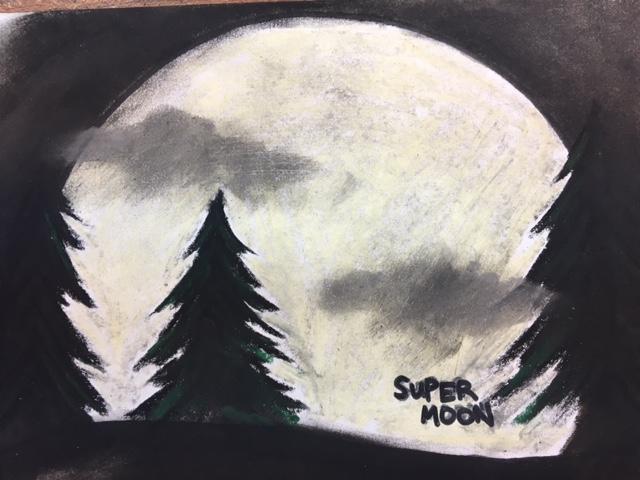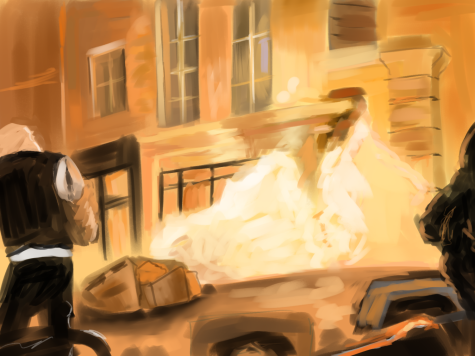Super Swoon over the Supermoon
December 10, 2016
Children all around the world gaped in awe at the sight; scientists feasted on the record-breaking view in front of them; professional photographers raced to capture the moment on camera. But why the hype?
On November 14, the Supermoon graced the entire world with its mind-blowing size and radiant glow. The phenomenal sight lived up to the expectation as the closest, brightest, and largest Supermoon since 1948. Scientists, astronomers, and astrologists alike assumed their positions to take in the decadence of such a picturesque scene Mother Nature had to offer, after keeping everyone waiting for 68 years!
As everyone knows, the moon revolves around the Earth by following its monthly lunar orbit. A Supermoon occurs when the moon is at its shortest distance from Earth. During the lunar orbit, the moon will pass through the perigee stage, which can be described as the point when the moon is the closest to Earth. It makes sense, because astronomers derived the term “perigee” from Greek words peri meaning near, and gee meaning Earth. Thus, when the full moon reaches the perigee stage of its orbit, it orbits ever so slightly closer, causing the full moon to appear fourteen percent bigger and thirty percent brighter.
Some wonder why the scientific community decided to give a grand event such a simplistic name. Anmol Singh’ 18 muses, “I understand how the moon really looks ‘super’ during this phenomena, but is this the only reason why it the event is named so frankly?”
According to modern folklore, a renowned astrologer coined the term “Supermoon,” which led to it becoming the official term to describe this phenomenon. However, the technical name for the Supermoon would technically be the perigee-syzygy.
Other than providing a breathtaking sight, the Supermoon did have effects on the planet. For example, Earth’s surface, which is made up of about seventy percent water, experienced new tidal variations. As a direct result of the distance between the moon and the Earth rapidly shortening, slightly higher tides occurred.
Fortunately, scientists reassured the public that the Supermoon had no substantial effects on everyday life. Large structures such as mountains and skyscrapers felt what scientists refer to as “imperceptible” changes that still allow these formations to stand tall.
For some, the chances of catching a glimpse of the Supermoon are like the chances of it raining in the desert — very unlikely. Kyle Workman’17 testifies, “I really wanted to see the Supermoon in the flesh, but I just can never get the timing right. I never know when or where to look. An event this epic needs to be seen, and I feel like I am not alone in this quest.”
Since the Supermoon is a full moon, the moment the sun sets is the perfect time to start scoping out the scene. Rumor has is that the moon was so close to Earth that one was able to see all of the craters and indents on the moon’s surface with the naked eye. If one wants to get a sharper view, astrologists recommended using binoculars or a high power telescope. The full moon was set to be accessible to most locations around the world, with exceptions being in locations that have air or light pollution.
The November Supermoon of 2016 was historically ground breaking. It broke not only records but also the solemnness of the solid black night sky. People from all walks of life from all around the world were able to come together to witness such an enchanting evening. Such works of Nature are truly magical; they have the ability to unite many people and encourage them to put aside their differences. After all, everyone expresses pleasure in the same way: a smile. The scientific community predicts that the next Supermoon is set to grace us on November 25, 2034. Will you be smiling?




Emma Alexis • Dec 20, 2016 at 2:57 pm
This is a great idea to bring people in!
NIcoletta Agostino • Dec 20, 2016 at 2:56 pm
This was great! It really drew me in and you did an amazing job explaining.
Will Mahoney • Dec 20, 2016 at 2:54 pm
This is really interesting and the super moon is really cool
Meghan Convery • Dec 20, 2016 at 2:53 pm
This article is so inspiring and truly displays the true meaning of art
Meghan Convery • Dec 20, 2016 at 2:52 pm
Great article! It really helped to explain the events occurring in nature in an easy and understandable way! The art work was a good touch also! Hopefully I will read more articles soon!
Kavya Alapaty • Dec 20, 2016 at 2:50 pm
Wow!!! I love art. You guys really portrayed this art well. My best friend, Rebecca Lee, is also really into art. You should her out! @reblee99! 🙂
Jessica Booth • Dec 20, 2016 at 2:48 pm
This was a great article! Loved the writing and really enjoyed reading it, also really liked the art.
Camille Furst • Dec 20, 2016 at 2:47 pm
I saw this, it was super cool! Brings me back to the 8th grade moon project (never again)
Lauren Patetta • Dec 20, 2016 at 11:23 am
Lovely article! I love your description of the super moon, it truly was a spectacular event! There’s something very unifying about a natural event like this one. You did a great job capturing the atmosphere of this event!